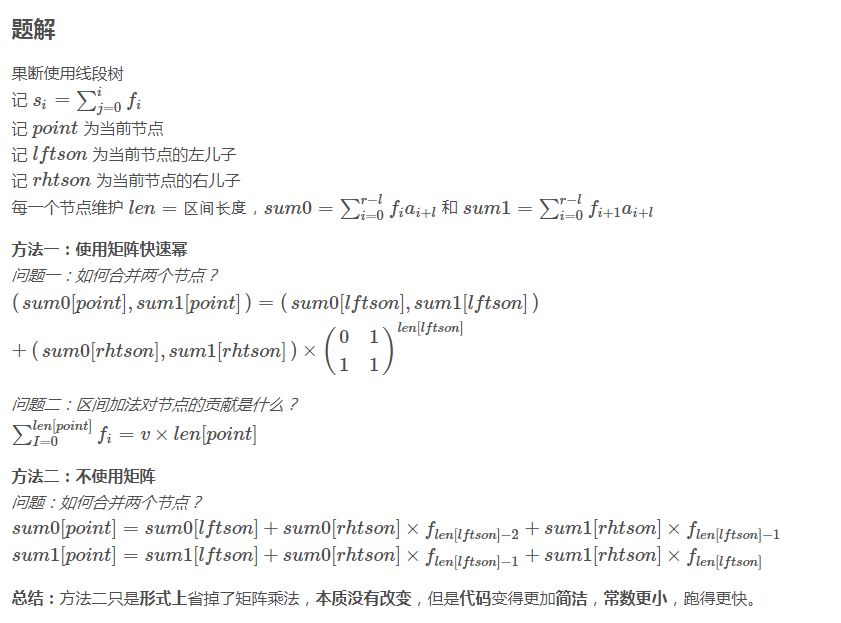codeforces316E3
Summer Homework
By the age of three Smart Beaver mastered all arithmetic operations and got this summer homework from the amazed teacher:
You are given a sequence of integers a1, a2, ..., an. Your task is to perform on it mconsecutive operations of the following type:
- For given numbers xi and vi assign value vi to element axi.
- For given numbers li and ri you've got to calculate sum
, where f0 = f1 = 1 and at i ≥ 2: fi = fi - 1 + fi - 2.
- For a group of three numbers li ri di you should increase value ax by di for all x (li ≤ x ≤ ri).
Smart Beaver planned a tour around great Canadian lakes, so he asked you to help him solve the given problem.
Input
The first line contains two integers n and m (1 ≤ n, m ≤ 2·105) — the number of integers in the sequence and the number of operations, correspondingly. The second line contains n integers a1, a2, ..., an (0 ≤ ai ≤ 105). Then follow m lines, each describes an operation. Each line starts with an integer ti (1 ≤ ti ≤ 3) — the operation type:
- if ti = 1, then next follow two integers xi vi (1 ≤ xi ≤ n, 0 ≤ vi ≤ 105);
- if ti = 2, then next follow two integers li ri (1 ≤ li ≤ ri ≤ n);
- if ti = 3, then next follow three integers li ri di (1 ≤ li ≤ ri ≤ n, 0 ≤ di ≤ 105).
The input limits for scoring 30 points are (subproblem E1):
- It is guaranteed that n does not exceed 100, m does not exceed 10000 and there will be no queries of the 3-rd type.
The input limits for scoring 70 points are (subproblems E1+E2):
- It is guaranteed that there will be queries of the 1-st and 2-nd type only.
The input limits for scoring 100 points are (subproblems E1+E2+E3):
- No extra limitations.
Output
For each query print the calculated sum modulo 1000000000 (109).
Examples
5 5
1 3 1 2 4
2 1 4
2 1 5
2 2 4
1 3 10
2 1 5
12
32
8
50
5 4
1 3 1 2 4
3 1 4 1
2 2 4
1 2 10
2 1 5
12
45
sol:对于斐波那契数列,是有矩阵的递推公式的,搬一个讲的很好的blog

自己手撸一下,发现法2转移其实很好理解
如这样一个数列
1,2,3,4
斐波那契数列是1 1 2 3 5
S[0](1~2)是1*f[0]+2*f[1] S[1](1~2)是1*f[1]+2*f[2]
S[0](3~4)是3*f[0]+4*f[1] S[1](1~2)是3*f[1]+4*f[2]
转移S[0](1~4)是1*f[0]+2*f[1]+3*(f[0]*f[0]+f[1]*f[1])+4*(f[1]*f[0]+f[2]*f[1])
假如把这些看成矩阵乘法
这个例子太low了看个大一点的
数列1,2,3,4,5,6,7,8
S[0](1,8)直接看后面的
5*(f[0]*f[2]+f[1]*f[3])+6*(f[1]*f[2]+f[2]*f[3])+7*(f[2]*f[2]+f[3]*f[3])+8*(f[3]*f[2]+f[4]*f[3])
然后机智的发现f[0]=f[1]=1,所以f[0]*f[2]+f[1]*f[3]=f[4] 容易知道f[0]*矩阵k=f[1] f[1]*矩阵k=f[2] 所以f[1]*f[2]+f[2]*f[3]就是f[4]*矩阵k=f[5]
容易发现f[0]*f[2]+f[1]*f[3]=f[4] f[1]*f[2]+f[2]*f[3]=f[5] 这样就做完了qaq
k=1 1
1 0

#include <bits/stdc++.h> using namespace std; typedef long long ll; inline ll read() { ll s=0; bool f=0; char ch=' '; while(!isdigit(ch)) {f|=(ch=='-'); ch=getchar();} while(isdigit(ch)) {s=(s<<3)+(s<<1)+(ch^48); ch=getchar();} return (f)?(-s):(s); } #define R(x) x=read() inline void write(ll x) { if(x<0) {putchar('-'); x=-x;} if(x<10) {putchar(x+'0'); return;} write(x/10); putchar((x%10)+'0'); } #define W(x) write(x),putchar(' ') #define Wl(x) write(x),putchar('\n') const int N=200005; const ll Mod=1000000000; int n,m; ll a[N],f[N],fs[N]; inline int fei(int x){if(x<0)return 0;else return f[x];} struct Node { ll le,S[2],lazy; }T[N<<2]; #define c1 (x<<1) #define c2 (x<<1|1) inline ll Ad(ll x,ll y) {x+=y; x-=(x>=Mod)?Mod:0; x+=(x<0)?Mod:0; return x;} inline ll Ad(ll x,ll y,ll z){return Ad(Ad(x,y),z);} inline ll Mul(ll x,ll y) {return 1ll*x*y%Mod;} inline Node Merg(Node a,Node b) { Node ans; ans.le=a.le+b.le; ans.lazy=0; ans.S[0]=Ad(a.S[0],Mul(b.S[0],fei(a.le-2)),Mul(b.S[1],fei(a.le-1))); ans.S[1]=Ad(a.S[1],Mul(b.S[0],fei(a.le-1)),Mul(b.S[1],fei(a.le))); return ans; } inline void F5(Node &a,ll oo) { a.S[0]=Ad(a.S[0],Mul(oo,fs[a.le-1])); a.S[1]=Ad(a.S[1],Ad(Mul(oo,fs[a.le]),-oo)); } inline void PushDown(int x) { if(!T[x].lazy) return; T[c1].lazy=Ad(T[c1].lazy,T[x].lazy); F5(T[c1],T[x].lazy); T[c2].lazy=Ad(T[c2].lazy,T[x].lazy); F5(T[c2],T[x].lazy); T[x].lazy=0; } inline void Build(int x,int l,int r) { T[x].le=r-l+1; T[x].lazy=0; if(l==r) { T[x].S[0]=T[x].S[1]=a[l]; return; } int mid=(l+r)>>1; Build(c1,l,mid); Build(c2,mid+1,r); T[x]=Merg(T[c1],T[c2]); } inline void Chag(int x,int l,int r,int Pos,ll Val) { if(l==r) { T[x].S[0]=T[x].S[1]=Val; return; } PushDown(x); int mid=(l+r)>>1; if(Pos<=mid) Chag(c1,l,mid,Pos,Val); else Chag(c2,mid+1,r,Pos,Val); T[x]=Merg(T[c1],T[c2]); } inline Node Que(int x,int l,int r,int ql,int qr) { // cout<<l<<' '<<r<<' '<<ql<<' '<<qr<<" "<<T[x].S[0]<<endl; if(ql==l&&qr==r) return T[x]; PushDown(x); int mid=(l+r)>>1; if(qr<=mid) return Que(c1,l,mid,ql,qr); else if(ql>mid) return Que(c2,mid+1,r,ql,qr); else return Merg(Que(c1,l,mid,ql,mid),Que(c2,mid+1,r,mid+1,qr)); T[x]=Merg(T[c1],T[c2]); } inline void Updata(int x,int l,int r,int ql,int qr,ll Val) { if(ql==l&&qr==r) { T[x].lazy=Ad(T[x].lazy,Val); F5(T[x],Val); return; } PushDown(x); int mid=(l+r)>>1; if(qr<=mid) Updata(c1,l,mid,ql,qr,Val); else if(ql>mid) Updata(c2,mid+1,r,ql,qr,Val); else Updata(c1,l,mid,ql,mid,Val),Updata(c2,mid+1,r,mid+1,qr,Val); T[x]=Merg(T[c1],T[c2]); } int main() { int i; R(n); R(m); for(i=1;i<=n;i++) R(a[i]); f[0]=f[1]=1; for(i=2;i<=n;i++) f[i]=Ad(f[i-1],f[i-2]); fs[0]=1; for(i=1;i<=n;i++) fs[i]=Ad(fs[i-1],f[i]); Build(1,1,n); // cout<<"!!!!"<<Que(1,1,n,4,4).S[0]<<endl; // return 0; while(m--) { int opt; ll x,y,z; R(opt); R(x); R(y); if(opt==1) { Chag(1,1,n,x,y); } else if(opt==2) { if(x>y) swap(x,y); Node ans=Que(1,1,n,x,y); Wl(ans.S[0]); } else if(opt==3) { R(z); Updata(1,1,n,x,y,z); } } return 0; } /* Input 5 5 1 3 1 2 4 2 1 4 2 1 5 2 2 4 1 3 10 2 1 5 Output 12 32 8 50 Input 5 4 1 3 1 2 4 3 1 4 1 2 2 4 1 2 10 2 1 5 Output 12 45 */





